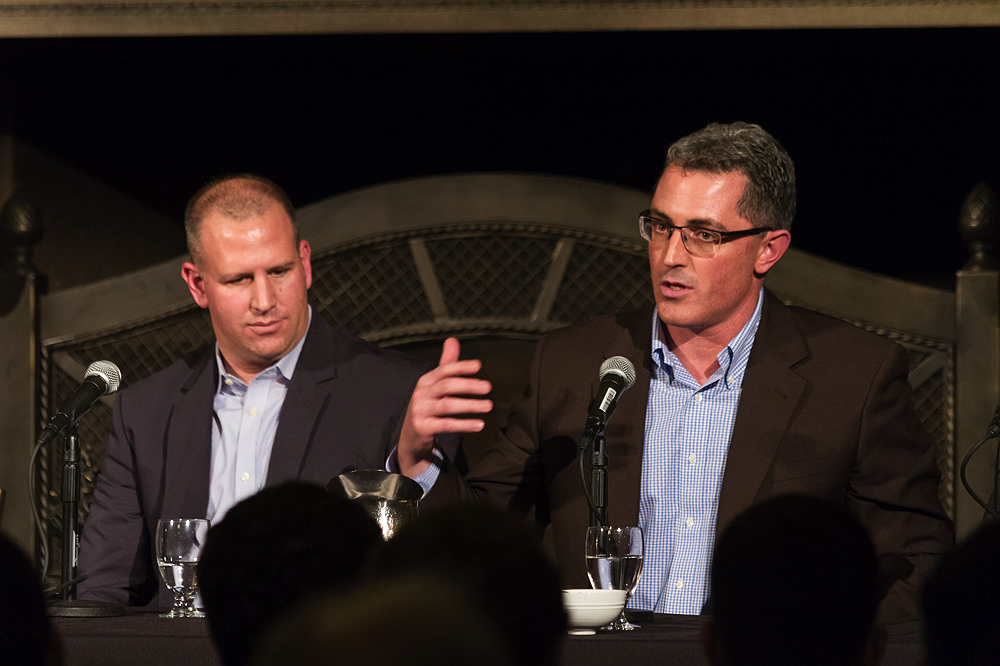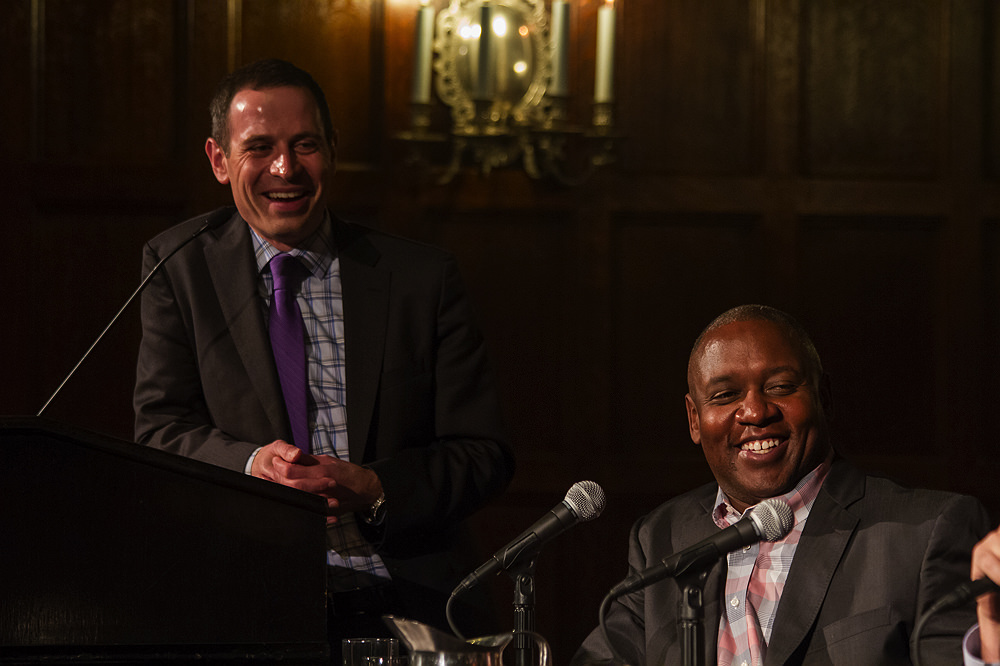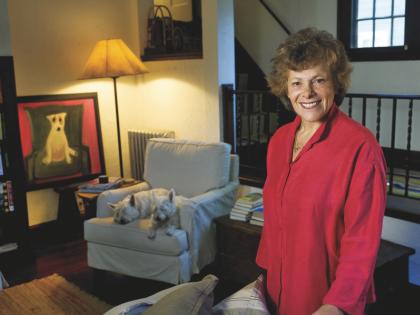They talked about the global game of baseball and the passion that keeps them in it and the young players—getting younger every year—whom they now steer through major-league careers. They relived past glories on O’Donnell Field and retraced the winding paths that got them where they are. They talked about rebuilding efforts and pace of play and making trades. They talked about their moms.
On a drizzly January night, not quite on the doorstep of spring training, five Harvard-educated Major League Baseball (MLB) executives came to the Harvard Club of Boston for a wide-ranging Q&A, co-sponsored by the Friends of Harvard Baseball and the Harvard Varsity Club. This was the lineup:
Michael Hill ’93, president of baseball operations for the Miami Marlins;
David Forst ’98, general manager of the Oakland As;
Peter Woodfork ’99, MLB senior vice president of baseball operations;
Jeff Bridich ’00, senior vice president and general manager of the Colorado Rockies;
and Ben Crockett ’02, vice president of player development for Boston’s own Red Sox.
Led along—and once or twice lightly interrogated—by the MLB Network’s Jon Morosi ’04, while the current Crimson baseball team, in suits and ties, listened from the front rows, the panelists dug into their own experiences and the issues facing the game. But the subject they kept returning to was those young men on the field. Bridich recalled an earlier job in player development, and the lessons it taught him about the gravity of holding young players’ “dreams in your hands,” as Morosi phrased it. That responsibility included 18-year-old sudden millionaires who were away from home for the first time in their lives, and minor leaguers desperate to make it to the next level. “When you release a minor-league kid and you know that this is the last time he’s going to play ball, it’s different,” Bridich said. “It hurts more than when we release a big leaguer that we know is probably going to get a job somewhere else.…Those tears that come from that 25-year-old kid you’re releasing from high A-ball, that hurts more than all the times I’ve sat with a big leaguer and said, ‘I’m sorry, we don’t have a spot for you anymore.’”

Forst talked about the shifting system that often places teenagers on major league squads, skipping the step that in earlier eras allowed young players to mature in the minor leagues before they ventured into the glare of the MLB. “These kids get to the big league because they’re talented, but like you said, Jeff, they’re not fully developed as people,” Forst said. “So we’re caretakers for these 25 people who you have to somehow shape into a unit and try to win.”
A changing media climate adds another dimension, Crockett chimed in. Younger players reaching greater heights earlier in their lives must also handle higher expectations, and with less room for error. Before social media and the Internet’s 24-hour news cycle, “Guys could make mistakes, even at the big-league level, on or off the field…and learn from those.” Now those mistakes don’t just mean a rebuke from a coach or a team captain—they become stories. And the high pressures, if ignored, Bridich added, “often manifest themselves as problems later on in their careers.” It becomes important, he said, to find players whom the coaches and managers trust and respect and enlist them to help lead the team and make their teammates better. “That’s been huge for us,” he said, especially in an industry as competitive as baseball, “where the guy sitting next to you may take your job one day, and it might be tomorrow.”
Woodfork noted MLB efforts to raise the league’s global profile and recruit more players from outside the United States. “We spend a lot of money trying to grow the game internationally,” he said, adding that it’s also important to promote more people of color into positions of power. Hill, an African American, “is one of our few people of color that’s a GM, a final decision-maker.” Recalling a Harvard course he took with the late historian William Gienapp, “Baseball and American Society, 1840-Present,” Woodfork said that baseball is “usually pretty reflective” of what’s happening in the country, and “as the country becomes more and more diverse, the goal is to have the game look that way.”
Which led the conversation back to the players. Hill, working in Miami, talked about speaking Spanish as an important way to bond with players new not only to the MLB but the United States. “We talk about bringing a 16-year-old from the Dominican Republic whose family makes $1,000 a year, and plucking them out of their country and dropping them in the States and then telling them to go get three hits on Field Seven during spring training.…That’s an adjustment. It started back when I was playing—I tried to be a liaison for all of our Dominican players, just to help them adjust, get comfortable.”

Bridich recalled his first trip to the Dominican Republic, to visit a 17-year-old prospect whose family lived in a one-room house with a tin roof and curtains dividing one living space from another. That trip provided “one of the biggest lessons I ever learned in this game,” he said. When they reach the MLB, “Almost everything is foreign to these kids.…It’s important for people like us to truly go to the roots and understand the people that are entering this game and the people that we are responsible for, ultimately.”
Morosi asked the panel about the problem of baseball’s slow pace of play compared to other sports, a question that seemed to find no answer—except that an answer must be found. “I don’t see anywhere, at least in my part of the country, where the problem is kids playing the game,” Forst said. Little Leagues are full of eager participants. “Where we have issues is with people watching and following the game.…It’s no secret that the fans and the networks and the people who pay the bills are demanding that it’s something that we need to change.”
Added Woodfork: “People like to go to games.…Where it falls apart is when you go to commercial for three and a half minutes, and there’s six pitching changes”—as coaches try to switch up left- or right-handed pitchers to maximize their strength against specific hitters. Sometimes this means multiple switches within a single inning—“lefty, righty, lefty, righty,” he said—slowing the game and breaking the flow. “And that’s bad television.”
When the floor opened to questions from the audience, one man rose with an ardent query about whether, in this age of data and analytics, baseball executives still “look for something in here,” as he put it, knocking at his chest. “For heart, for soul, for chemistry.” Of course, came the reply. A young man stepped up to announce he would be starting as a video coordinator with an MLB club, though his ambitions are far loftier, and did the panel have any advice for him? “You know your passion, but take care of the job at hand,” Hill advised—and then ask for more responsibilities. “Mike’s right,” seconded Bridich. “Kick butt at your job.…And then try to learn as much as you can.”
The toughest questions of the night came from fans worried about a trend toward rebuilding efforts that involve stripping teams down first—dumping talented, but expensive, players in order to rebuild a winning-caliber team—or intentionally tanking to try for higher draft picks. Would this now become how baseball works? Especially after World Series wins by the Cubs and the Astros, which pursued that strategy successfully, but at the expense of a few fan-sapping seasons of endless mediocrity and losses, “Is the league concerned that teams will see this as a logical strategy and follow it both in on-field competitiveness and the free-agent market?” wondered one audience member. The next questioner followed up with a similar worry: “Looking at it from a baseball fan perspective, do I feel comfortable that my team is trying to lose for a first draft pick?”

The panelists acknowledged the problem, but argued that the reality is not so simple. Bridich noted that the NBA faces a similar dilemma and is exploring ways to discourage intentional losses. Woodfork pointed out that only a year before the Cubs and the Astros each won their championships, the newspapers in their hometowns had called for their front-office executives to be fired. “So, you can do it, but if your timing is bad, you’re going to be in a lot of trouble.” Forst elaborated that point: “I will say, as somebody whose team is rebuilding,…what we’ve seen the last couple of years out of the Cubs and the Astros is not easy to do.” In other words, those teams threaded a needle—they were canny, but they were also lucky. “When they came out of their rebuild, they had incredible resources to draw on to get where they were going, but there are plenty of other examples that don’t end up that way. So I think as much as we are open for copycats in this industry, I don’t think you are faced with this being the norm.…There are a lot of ways to get to where the Cubs and the Astros have gotten.”
And then finally, they came to moms, prompted by a question at the mic from Bridich’s father, former Crimson baseball player Rick Bridich ’73. Forst recalled how his mother—“the one who loved baseball just about as much as anybody in our house”—moved from California to Cambridge and took an apartment on DeWolfe Street during his senior season and went to every game. Crockett’s mother, who was not a fan, learned the game “completely on the fly.” Bridich remembered the undergraduate struggles his mother and father got him through, an early experience in failure that they knew would be all right, even when he did not.
Hill offered a similar story, from a time when he himself was a young man on the field, with big, anxious hopes. A dual athlete in baseball and football, and “a young kid from Cincinnati who never thought I’d be an Ivy graduate,” he spent his freshman fall in practices for both sports and tried to study on top of everything. His first big stumble was a class called, as he remembered it, “Math 1b.” “But there was nothing math about it,” Hill told the audience. “I was like, ‘Where are the numbers?’ There were no numbers.” That first semester, “I got crushed.” One test came back “looking like the Valentine’s Day Massacre—grades I didn’t even know existed.” He called his mother. “I said, ‘I don’t know about this, Mom.’” But she did. She told him he could do it, and somehow that made it true. “And I never looked back.”









